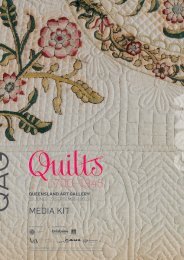Paperskin: barkcloth across the Pacific - Queensland Art Gallery
Paperskin: barkcloth across the Pacific - Queensland Art Gallery
Paperskin: barkcloth across the Pacific - Queensland Art Gallery
You also want an ePaper? Increase the reach of your titles
YUMPU automatically turns print PDFs into web optimized ePapers that Google loves.
Preface<br />
Nicholas Thomas<br />
since <strong>the</strong> eighteenth century, <strong>the</strong> <strong>barkcloth</strong> of <strong>the</strong> <strong>Pacific</strong> has intrigued travellers and<br />
captured <strong>the</strong> attention of connoisseurs in europe. From <strong>the</strong> 1770s, <strong>the</strong> decoration of<br />
Tongan ngatu, hawaiian kapa and o<strong>the</strong>r fabrics sparked <strong>the</strong> interest of collectors, and<br />
soon after Cook’s voyages, sheets of <strong>barkcloth</strong> began to be cut up for distribution<br />
among albums of samples. it was briefly <strong>the</strong> fashion for london ladies to adapt <strong>the</strong>ir<br />
garments, incorporating tapa, which has thus been a cross-cultural fabric for nearly<br />
250 years.<br />
if, early on, <strong>barkcloth</strong> spoke eloquently of <strong>the</strong> exotic, it is strange that it has only recently<br />
been seriously studied, and only recently recognised as a major Oceanic art form. Though<br />
<strong>the</strong>re are brief reports and discussions scattered through many early anthropological<br />
monographs, it was only in 1972 that a book dedicated to tapa in Polynesia (by simon<br />
Kooijman, a Dutch anthropologist) was published, and still more recently that a book (Neich<br />
and Pendergrast’s 1997 <strong>Pacific</strong> Tapa) with colour plates appeared, that could be said to do<br />
justice to <strong>the</strong> aes<strong>the</strong>tics of <strong>the</strong> medium. There are, of course, explanations for this neglect.<br />
Tribal art studies and art markets have long been biased toward sculptural forms<br />
and toward works of art made by men, while fabrics have been neglected. equally<br />
unfortunate was <strong>the</strong> perception that patterned and painted cloth is merely ‘decorated’,<br />
and decoration, perceived as a lower-order, sub-artistic level of cultural creativity. until<br />
recently, <strong>the</strong>se fabrics were seen as bearers of patterns ra<strong>the</strong>r than works of art, and<br />
were typically exhibited as backdrops in museum display cases ra<strong>the</strong>r than presented<br />
as objects that could be appreciated for <strong>the</strong>ir integral value.<br />
No major art exhibition has been dedicated to <strong>barkcloth</strong> until now. ‘<strong>Paperskin</strong>’ is a<br />
landmark project that brings into view a stunning selection of fabrics, primarily from <strong>the</strong><br />
rich but largely un-researched collections of Te Papa and <strong>the</strong> <strong>Queensland</strong> Museum.<br />
some of <strong>the</strong>se — <strong>the</strong> samoan, hawaiian and Fijian examples — will be familiar to those<br />
who already have an interest in <strong>the</strong> genre. but some, such as <strong>the</strong> animated Niuean<br />
Hiapo (detail) 19th century<br />
Niue (attributed)<br />
Barkcloth, dye / 105 x 171.5cm /<br />
Collection: Museum of New<br />
Zealand Te Papa Tongarewa<br />
hiapo example, are extraordinary and unlike any o<strong>the</strong>r Niuean piece in any collection,<br />
anywhere in <strong>the</strong> world. Hiapo such as <strong>the</strong>se remind us that <strong>the</strong>y are not examples of<br />
an object type but unique works of art. At <strong>the</strong> same time, <strong>barkcloth</strong>s are not solely, or<br />
not exactly, works of art: <strong>the</strong> terminological debate is ultimately unproductive, but it is<br />
important to remember that <strong>the</strong>se were not made for aes<strong>the</strong>tic appreciation in a narrow<br />
sense, but ra<strong>the</strong>r to constitute sanctity, to define a ceremony, to wrap around a body,<br />
to bear knowledge or to effect a gift. These art forms were embedded in <strong>the</strong> lives of<br />
<strong>Pacific</strong> islanders and in many places, and in many ways, <strong>the</strong>y still are.<br />
The curators are to be congratulated on a sparkling and singular exhibition which may<br />
be <strong>the</strong> first but should definitely not be <strong>the</strong> last. let us hope that it encourages islanders,<br />
artists, students, curators and o<strong>the</strong>r interested people to look again, and more intently, at<br />
<strong>the</strong> <strong>barkcloth</strong> of <strong>the</strong> <strong>Pacific</strong>.<br />
Nicholas Thomas is Director of <strong>the</strong> Museum of Archaeology and Anthropology and Professor of historical<br />
Anthropology, Cambridge university.<br />
8 9

















